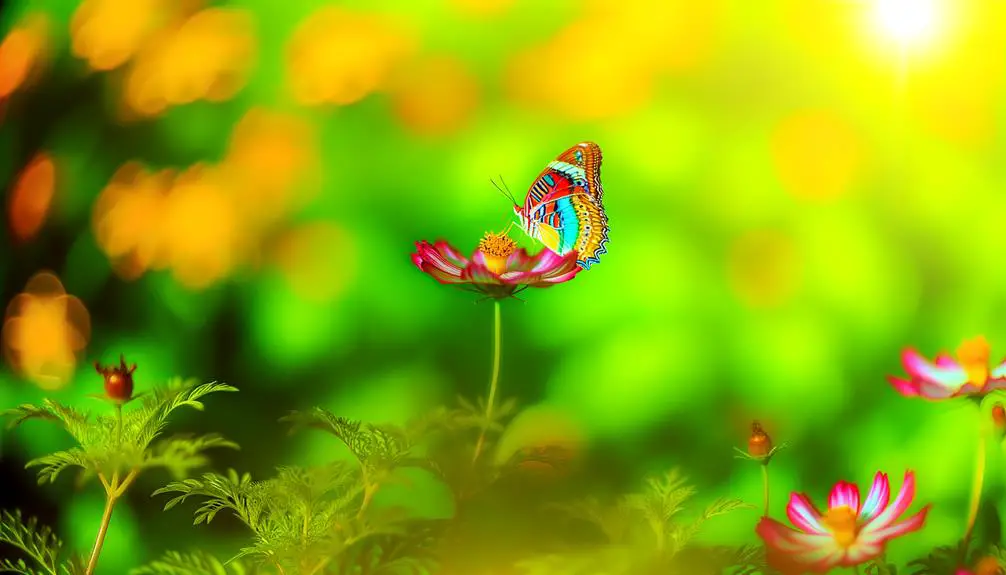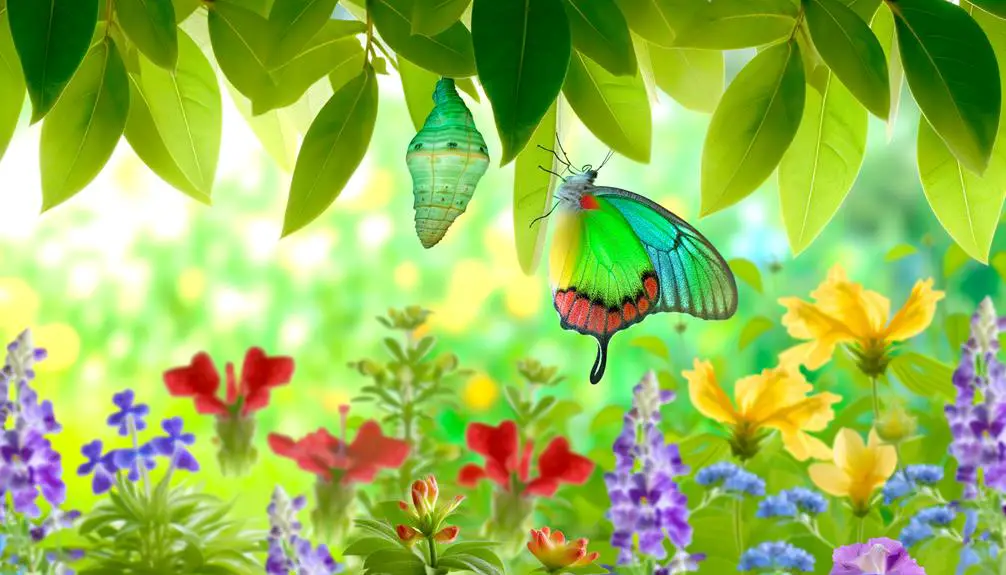How Are Butterflies Symbolic Across Cultures?
Butterflies symbolize transformation and renewal, underpinned by their complex metamorphic life cycle. This extraordinary process, from egg to adult, symbolizes adaptability and resilience, paralleling human personal development.
Studied across cultures, they are emblematic of spiritual growth and rebirth, often representing the soul's journey and resurrection. In many traditions, such as Native American and Japanese, they are viewed as spiritual messengers, connecting earthly existence with the divine.
Additionally, butterflies evoke themes of love, joy, and freedom due to their vibrant appearance and fleeting presence. Exploring these multifaceted symbols offers profound insights into human experiences and beliefs.

Key Takeaways
- Butterflies symbolize transformation and personal growth through their metamorphic life cycle.
- They represent spiritual growth and enlightenment, reflecting stages of human psychological development.
- Butterflies are seen as symbols of resurrection and the soul's journey in various cultures.
- They are associated with love, joy, and the fleeting beauty of life.
Transformation and Change

Butterflies are universally recognized as powerful symbols of transformation and change, largely due to their distinct and well-documented metamorphic life cycle. This cycle includes four distinct stages: egg, larva (caterpillar), pupa (chrysalis), and adult. Each stage represents a drastic morphological and physiological transformation, meticulously studied by entomologists.
Research indicates that during the pupal stage, the caterpillar undergoes histolysis, where its tissues break down and reorganize into the butterfly's adult form. This remarkable biological process signifies not only physical change but also adaptability and resilience.
The butterfly's life cycle exemplifies the potential for profound change, making it an ideal subject for scientific inquiry and a potent metaphor for personal development and rejuvenation.
Spiritual Growth
The profound biological transformations observed in butterflies also offer a compelling framework for understanding spiritual growth, wherein each stage of the butterfly's life cycle can be metaphorically aligned with stages of spiritual development.
The egg stage represents potential and the inception of spiritual awakening.
The larval stage, characterized by voracious feeding, symbolizes the accumulation of knowledge and experiences.
The pupal stage, marked by profound internal reorganization within the chrysalis, mirrors deep introspection and personal transformation.
Finally, the emergence of the adult butterfly signifies the attainment of spiritual maturity and enlightenment.
Research indicates these stages parallel human psychological development, suggesting that like the butterfly, individuals must undergo phases of growth, learning, and transformation to achieve spiritual fulfillment.
Resurrection and Rebirth

Numerous studies have illustrated how the cyclical nature of a butterfly's life serves as a potent symbol for concepts of resurrection and rebirth across various cultures and spiritual traditions.
Detailed observations reveal that the metamorphosis from caterpillar to butterfly is often interpreted as a metaphor for transformative processes. Research indicates that this transformation embodies the idea of death and subsequent rebirth, paralleling natural cycles of decay and renewal.
For instance, in Christian iconography, the butterfly's emergence from its chrysalis is likened to Christ's resurrection. Similarly, ancient Egyptian texts emphasize the butterfly as a symbol of the soul's journey through death to a renewed existence.
Consequently, the butterfly's life stages provide a profound representation of resurrection and rebirth.
The Soul and Afterlife
In numerous cultural and spiritual traditions, the butterfly is emblematic of the soul and the afterlife, symbolizing the transformation and rebirth inherent in the journey of the spirit.
Research indicates that butterflies are often perceived as spiritual messengers, bridging the earthly domain and the eternal.
This symbolism is further reinforced by their life cycle, which mirrors the concept of eternal life through stages of metamorphosis, from caterpillar to chrysalis to butterfly.
Transformation and Rebirth
Butterflies, often regarded as symbols of transformation, serve as poignant metaphors for the concepts of rebirth and the soul's journey in various cultural and spiritual contexts. The metamorphosis from caterpillar to butterfly is an emblematic representation of profound change.
This biological process mirrors the human experiences of growth and renewal, as evidenced by research in cultural anthropology. In many traditions, the butterfly's emergence from the chrysalis is analogous to the soul's liberation from the mortal coil.
Scientific studies have observed that the intricate stages of metamorphosis involve cellular reorganization and gene expression changes, paralleling philosophical notions of personal and spiritual evolution. This symbolic association underscores the butterfly's revered status as a harbinger of new beginnings and philosophical rejuvenation.
Spiritual Messenger Significance
The butterfly is often regarded in various cultural and spiritual traditions as a significant spiritual messenger, symbolizing the soul’s journey and the afterlife. Ethnographic studies reveal that in many indigenous cultures, butterflies are seen as carriers of the soul, shifting between dimensions. This deep-rooted belief connects to the transformation process butterflies undergo, mirroring the soul’s evolution and transcendence. Many people find comfort in the spiritual meaning of butterflies, seeing them as signs from departed loved ones or as gentle reminders of personal growth. Across various traditions, their presence is often interpreted as a message of hope, renewal, or guidance from the unseen world.
In Mexican folklore, particularly during Día de los Muertos, butterflies are believed to carry the spirits of the deceased back to the living world.
Scientific observations indicate that the butterfly's metamorphosis mirrors human beliefs in spiritual transformation and continuity beyond physical death. Research in thanatology—the scientific study of death—suggests that such symbolic representations provide comfort and a sense of connection to the departed, reinforcing the butterfly's role as a spiritual liaison.
Eternal Life Symbolism
Numerous cultures and spiritual traditions across the globe attribute butterflies with the symbolism of eternal life, viewing them as representations of the soul's immortality and the continuity of existence beyond physical death.
In ancient Greek mythology, the word 'psyche' encompassed both 'soul' and 'butterfly,' illustrating this symbolic connection. Similarly, in Mexican traditions, butterflies are believed to carry the souls of deceased ancestors during the Day of the Dead celebrations.
Contemporary research in cultural anthropology supports these associations, highlighting butterflies in funerary art and rituals across civilizations. Such symbolism underscores a universal human desire to comprehend and symbolize the transcendence of the soul, reflecting a collective hope for an existence beyond the mortal domain.
Love and Joy

In various cultural and psychological studies, butterflies have been consistently associated with manifestations of love and joy, symbolizing transformation and the ephemeral nature of these emotions.
Research indicates that the metamorphosis of a butterfly—from caterpillar to chrysalis to adult—parallels the transformative journey of love, marked by growth and significant changes.
Similarly, the fleeting lifespan of butterflies mirrors the transitory moments of joy, emphasizing their precious and delicate nature.
Observational studies have noted that the vibrant colors and light, airy movements of butterflies often evoke feelings of happiness and affection in human observers.
This has led to the butterfly being a common motif in art and literature as an emblem of the beauty and tenderness inherent in love and joy.
Cultural Symbolism
Cultural interpretations of butterflies frequently highlight themes of transformation and rebirth, as evidenced by their life cycle from caterpillar to adult.
Research indicates that butterflies also symbolize freedom and change, reflecting their ability to traverse vast distances.
Additionally, various cultures regard butterflies as spiritual messengers, attributing significant metaphysical and religious meanings to their presence.
Transformation and Rebirth
The metamorphosis of butterflies serves as a powerful emblem of transformation and rebirth, deeply rooted in the mythologies and spiritual practices of various cultures worldwide.
Scientific observations reveal that the butterfly's life cycle—from egg to caterpillar to chrysalis and finally to adult butterfly—mirrors profound personal and spiritual growth.
Research indicates that many cultures view this process as symbolic of:
- Personal metamorphosis: Reflecting significant life changes and personal evolution.
- Spiritual rebirth: Suggesting renewal and the emergence of a higher spiritual state.
- Seasonal cycles: Representing the natural shifts within the environment.
These symbols illustrate the universal respect for the butterfly as a potent icon of life's transformative journey.
Freedom and Change
Butterflies are frequently regarded as symbols of freedom and change, manifesting in various cultural traditions as representations of liberation from constraints and the continuous evolution of life. This symbolism is evident in numerous anthropological studies.
For instance, in Japanese culture, butterflies are seen as souls freed from earthly bonds, symbolizing personal transformation and the transient nature of existence. Similarly, in Native American traditions, the butterfly signifies renewal and the capacity to navigate life's transformations with grace.
Research in cultural anthropology supports these interpretations, noting that the butterfly's metamorphosis—from caterpillar to chrysalis to adult—mirrors the human experience of growth and change. Consequently, the butterfly is emblematic of the dynamic and ever-evolving journey of life.
Spiritual Messengers
In many cultures, butterflies are regarded as spiritual messengers, believed to carry messages from the divine or the deceased, a concept supported by ethnographic studies and historical accounts.
Research indicates that these delicate creatures are often seen as intermediaries between dimensions, embodying transcendence and transformation. Various traditions highlight their symbolic significance:
- Native American beliefs: Butterflies are thought to carry wishes to the Great Spirit.
- Mexican culture: Monarch butterflies are considered souls of the deceased, returning each year.
- Japanese folklore: Butterflies embody the presence of loved ones who have passed away.
Such cultural attributions underscore the butterfly's role as a profound spiritual symbol across civilizations.
Conclusion
To sum up, butterflies serve as potent symbols across various cultures and contexts, embodying transformation, spiritual growth, and the cycle of life and death.
A fascinating statistic reveals that over 160,000 species of butterflies exist worldwide, each representing unique cultural narratives and meanings. This diversity underscores the butterfly's universal appeal and profound symbolic significance.
Extensive research supports these interpretations, suggesting that the butterfly's metamorphosis resonates deeply with human experiences of change and renewal.







It’s greatest to focus on sustainable, healthy methods to construct
muscle and stay fit. You’ll also forestall the potential physical and psychological harm of counting on synthetic substances to achieve the level of fitness you need in the process.
The Drug Enforcement Administration (DEA) classifies AAS as Schedule III medication. Simply possessing
them illegally (not prescribed to you by a doctor) can lead to up to a year in prison and a
fantastic of at least $1,000 for a first-time offense.
One study proves that at low doses (1-20 µM) curcumin inhibits
secretion of cortisol. Turmeric has additionally been discovered to
exert comparable protective effects on the lungs and other parts of the physique by advantage of its therapeutic antioxidant and anti inflammatory effects.
One Other research on turmeric and steroids a very common disease of the oral cavity offered similar
results.
In conclusion, it’s clear that there are pure options to steroids that can allow you to
obtain your objectives of bulking up whereas avoiding the severe and dangerous side effects of anabolic steroids.
While an illegal anabolic steroid contains synthetic testosterone derivatives,
the best legal steroids rely on natural plant-based ingredients
to spice up muscles and energy big features at the gym.
In light of these security issues, the SARMs Control Act of 2019
was introduced to the Usa Congress, which seeks to tighten regulatory management over
these medicine.
Elements like vitamin D3, zinc, KSM-66, and Korean mistletoe work naturally for efficient testosterone assist.
Excessive dose vitamin C and the amino acid L-lysine
may help stop the rapid atherosclerosis brought on by Prednisone, so supplementation of each should be thought of at ranges of 3,000 mg.
Each or more, daily, in any Prednisone weaning-off program
assisted by your medical physician.
From muscle synthesis to sustaining excessive androgen ranges, CrazyBulk meets all of your
wants. Well-renowned for its testosterone-boosting talents
amongst bodybuilders, Testo Xplode is an efficient choice for anyone
seeking to boost testosterone ranges without counting on a prescription steroid.
If you’re trying to significantly bulk up and remodel your
physique, you then want the very best pure steroid
different on the market. The right natural steroid can result in bigger muscular tissues, heavier lifts, and larger
virility and vigor. Not all pure steroids are equal, though—some are way
more prone to result in muscle positive aspects than others.
A natural steroid can goal your body’s pure muscle-boosting
processes to reinforce or amplify them, helping you gain the good thing about your exercises more successfully.
The majority are joyful and will proceed taking it till they
achieve their dream physique. Yes, well-liked steroids in the marketplace, such as those on our list, provide a selection of
totally different well being benefits because of the plant
extract minerals and nutritional vitamins inside their formulation. On high of boosting natural muscle building hormones, like testosterone, every complement accommodates components that support a healthy metabolic
fee. This permits you to decrease the quantity of fat on your physique, supplying you with the prospect to sculpt your physique.
Taking mineral supplements with zinc and magnesium can increase testosterone.
In a current research, printed within the medical journal Schmerz (Pain),
(27) German doctors made a major discovery. Chronic lumbar ache syndromes without neurological (nerve and muscle) deficits can be attributable to many problems not simply what exhibits
up on an MRI scan in search of again pain. In many instances, a diseased intervertebral disc is found
on radiological examination but the medical relevance of these findings is not clear.
Again, the restrictions had been that this analysis
was not legitimate for sufferers who acquired high-dose corticosteroids and that the study group
was too small to supply an assessment. The sufferers
obtained better, however the researchers did not assume that the treatment with epidurals was the
rationale for it. (There are research to suggest that again and
leg pain can resolve itself or that a change of lifestyle or
daily habits might contribute to the alleviation of pain).
Prednisone can cause a variety of unwanted facet effects and will turn into ineffective with extended use.
It also can cause hypertrophy of the center,
and so it can only safely be used for several months at a time.
Our content material does not represent a medical or psychological consultation. For an in depth breakdown of one of the best HGH supplements for males, you can check with the total
article. Also, add the whole spice version of turmeric
to your meals all through the day (either within the powder
form or the whole root).
Dexamethasone is 5 to 6 occasions stronger than prednisone
regarding anti-inflammatory prospect and its impact lasts longer.
Its half-life is between 36 to seventy two hours, while
prednisone’s half-life is between 12 to 36 hours.
Synthetic options beat prednisone because
they’re generally more potent and last more.
Prednisone is a sort of corticosteroid treatment that may additionally be used as immunosuppressants if given in high doses along with treating many different
different conditions. Statements regarding complement
benefits have not been evaluated by the Meals and Drug Administration. Transparent Labs merchandise aren’t meant to diagnose, treat, remedy, or forestall
any disease.
Concerning COVID-19, researchers wouldn’t have a clear
reply either as to why these sorts of therapies are
profitable. Polycystic Ovary Syndrome (PCOS) is a standard and
uncomfortable hormonal condition that impacts ladies of reproductive age.
It is often treated with metformin, the popular diabetes treatment that has been linked to vitamin B12 deficiencies and lactic acidosis, among other negative
side effects. For hypertension sufferers, there’s a pure supplement that
may compete with lisinopril and different ACE inhibitors, in accordance with some analysis.
However it’s often present in smaller amounts, where
it’s used to keep bones sturdy and sexual operate healthy.
There’s nobody “go-to” biologic that’s one of the 2Ahukewipubipvmvnahuy7p4khwr8cqaq4lyoanoecaeqfw|the best steroids for muscle growth (jbhnews.com) for everybody with asthma, says Poole.
“Your doctor will use a customized method depending on the type of asthma you could have, your signs, and your well being history,” she says.
Steroids — synthetically enhanced corticosteroid hormones — block immune system responses to the toxins which
are overworking the system, giving relief from symptoms. Adrenal glands secrete
corticosteroids to fight irritation and regulate blood and electrolyte ranges in the body.
It’s inserted into the body and works by slowing your pet’s response
to injury or disease. Food and Drug Administration (FDA) warns against using SARMs or any dietary dietary
supplements containing these compounds. We assist the use of turmeric
for varied health conditions in people in addition to animals.
We are not liable for any contraindications one could face when taking turmeric as therapy without medical recommendation. In reality, turmeric has been confirmed to be better than steroidal drugs in several studies
for the treatment of rheumatological and inflammatory problems.
Nonetheless, this leads to liver damage, heart problems, or high blood pressure
due to the buildup of synthetic compounds in your bloodstream, resulting in a
better mortality fee. Overall, if you wish to improve your muscle features, energy and power, then legal steroids that really
work are the most secure option for your well being. Research have proven that
authorized steroid options like Trenorol can be simply
as effective as anabolic steroids however with out dangerous unwanted side effects.
If you’re on the lookout for the most effective legal steroid that’s secure and effective for building muscle and boosting your physique,
I extremely recommend CrazyBulk’s Final Stack. This powerful combination of authorized steroid
alternate options makes use of natural elements to help
improve muscle growth, energy, endurance, and power levels.